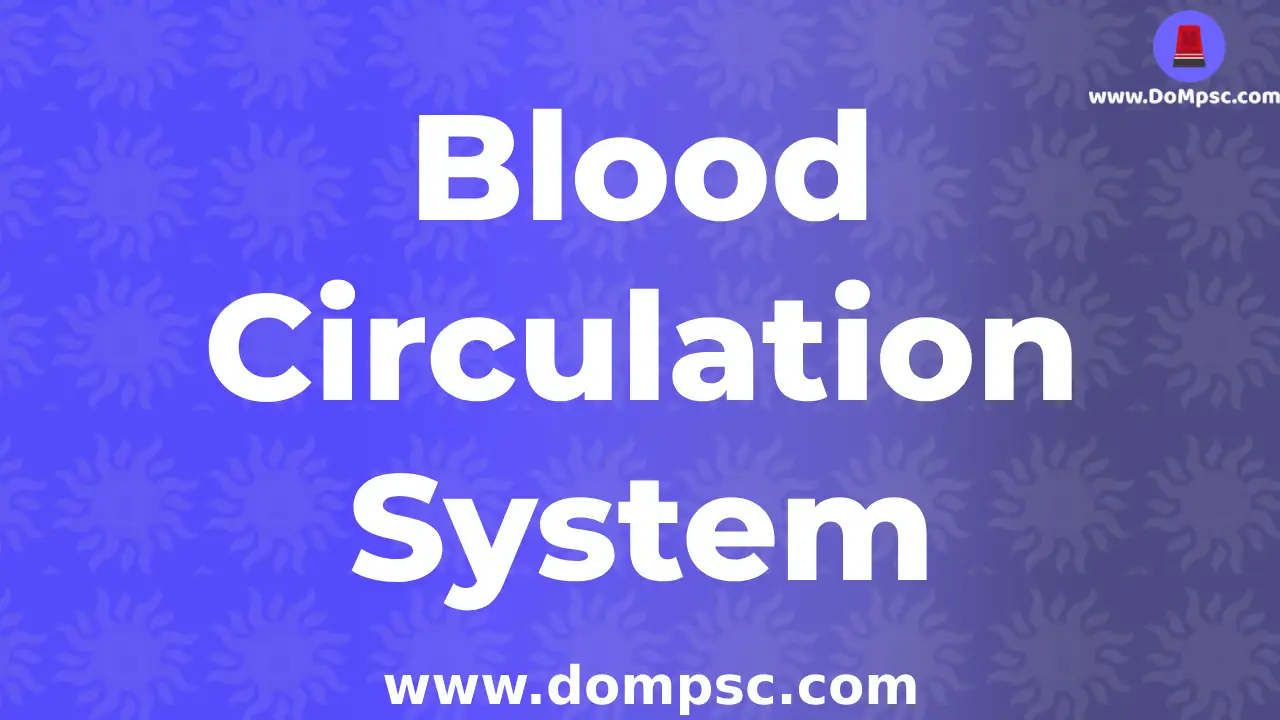MPSC blood circulation system(रक्ताभिसरण संस्था)-MPSC Biology science notes

blood circulation system रक्ताभिसरण संस्था
Table Of Contain-Mpsc Blood circulation system

By Shubham Vyawahare
19-September-2025
➤ It Was discovered By Williams harve So he is famous as a father of Angiology.
➤ Angiology is a branch of science which deals with the work of blood.
✪ There are two types of Blood Circulation System in the nature ✪
- Open Blood Circulation systems:There No Separate veins to circulate pure and impure blood.
- Close Blood circulation Systems: It has separate veins to circulate pure and impure blood.
✪ Three Important Factors Of human blood circulation system ✪
- Blood Vessels
- Blood
- Heart
1)Blood Vessels(रक्त वाहिन्या )
:There are three vessels are their in the human circulation system.1) artery 2) veins 3) Capillaries
➤ Circulate a oxygenated blood to body
➤ Only Pulmonary Artery Circulate impure blood.
➤ Deeply situated in body
➤ Does not have a valve
➤ High blood pressure
Veins➤ Circulate Blood from Body to heart.
➤ Circulate a deoxygenated blood to body
➤ Only Pulmonary veins Circulate pure blood.
➤ Not Deeply situated in body
➤ It Has a valve
➤ Medium blood pressure
Capillaries➤ Which Connect veins and Artery.
➤ Only Capillaries can transform air,food in between blood and cells.
1)Blood रक्त
:blood contain a)Plasma b)Blood cellsPlasma➤plasma is a 'yellowish liquid' of blood that holds the blood cells of whole blood in suspension. It is the liquid part of the blood that carries cells and proteins throughout the body. It makes up about 55% of the body's total blood volume
There Are 4 proteins Present in plasma.
- 1.Globulin
- 2.Albumin
- 3.Prothrombin
- 4.Fibrenogen
Blood Cells ➤there are three component in blood cells.
- RBC
- WBC
- Platletes
➤They are produced in red bone marrow.
➤Smaller than WBCs, 7.5µm
➤Filled with hemoglobin (Red)
➤Produces 2 million RBCs per second
➤ RBCs have an average lifespan of 120 days
➤Transport of Respiratory Gases (Oxygen and Carbon Dioxide)
WBC:➤ Also called “Leukocytes”
c Nucleus Present
➤ Mostly bone marrow, also produced in lymph nodes, spleen, etc
➤ Larger than RBCs, 15µm
➤ Colorless, No Pigment
➤ WBCs live anywhere from a few days (5-21 days)
➤ Rounded and Amoeboid, Irregular
➤ Defense Mechanisms
Plateletes:➤The blood platelets are the smallest cells of the blood, averaging about 2 to 4 μm in diameter
➤ they lack a nucleus and are incapable of cell division (mitosis), but they have a more complex metabolism and internal structure than have the red cells
➤ The function of the platelets is related to hemostasis, the prevention and control of bleeding
➤ Plateletes live anywhere from a few days (5-10 days)
➤ they are too small 2.5 to 5 micrometer diameter
➤ Generally 2.5 to 5 lakh plateletes present per cubic mm in blood
Lyamphatic systems
There are another systems present in the human body that circulate colorless protein liquid in the body is known as the lymphatic system. .➤ Circulates in all system except coordination systems
➤ Its circulate throw lymph node
➤ It has walve in nodes
➤ thoracic duct work in left side body
➤ right lymphatic duct work in right side of body
➤ In has high presence in underarms, Neck and thigh.
3) Human Heart
:➤ It is Involuntary Pump present in the body.➤ heart weighs between about 10 to 12 ounces (280 to 340 grams) in men and 8 to 10 ounces (230 to 280 gram ) in woman
➤ It has a capacity of contraction and Relaxation
➤ It is present in the middle theorasic.
➤ The heart beats about 100,000 times per day (about 3 billion beats in a lifetime).
➤ An adult heart beats about 60 to 80 times per minute.
➤ Newborns' hearts beat faster than adult hearts, about 70 to 190 beats per minute.
➤ The heart pumps about 6 quarts (5.7 liters) of blood throughout the body.
➤ The heart is located in the center of the chest, usually pointing slightly left.
✪ The heart has four chambers ✪
➤ The right atrium receives blood from the veins and pumps it to the right ventricle.
➤ The right ventricle receives blood from the right atrium and pumps it to the lungs, where it is loaded with oxygen.
➤ The left atrium receives oxygenated blood from the lungs and pumps it to the left ventricle.
➤ The left ventricle (the strongest chamber) pumps oxygen-rich blood to the rest of the body. The left ventricle’s vigorous contractions create our blood pressure.
Others Blogs Related to MPSC Biology Notes
➤Biology Exam Pattern
➤Blood Circulation System
➤Blood Groups And Its Diseases
➤Balanced Diet And Nutrients
➤Classification Of Animals
➤Classification OF Plants
➤Cell
➤Tissue
➤Coordination In Human
➤Digestive System
➤Diseases And Disease Types
➤Excretory System
➤Respiratory System
➤Reproductive System
➤Skeletal System
Read All MPSC blogs
- ➤केंद्र सरकारने खाजगी क्लासेस साठी नवी नियमावली लागू केली आहे |GUIDELINES FOR REGULATION OF COACHING CENTER in marathi
- ➤MPSC Data leak: पेपर न फुटल्याचा दावा MPSC आयोगाने स्पष्टपणे केला आहे
- ➤MPSC hall ticket data leaked before 6 days of exam
- ➤MPSC Data leak: टेलेग्राम वर अचानक ९० हजार परीक्षार्थींचे प्रवेशपत्र झाले लिक
- ➤मराठी भाषेला अभिजात दर्जा मिळायला हवाच , अभिजात दर्जा नेमका कसा मिळतो ?
MPSC Books pdf



